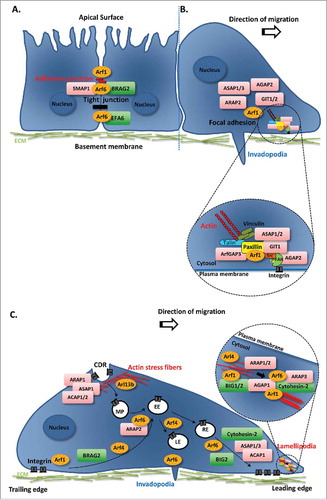Figures & data
Table 1. Expression of Arf family proteins in neoplastic tissues and cancer cells. (+) upregulated; (−) downregulated.
Table 2. Expression of Arf guanine nucleotide exchange factors in neoplastic tissues and cancer cells. (+) upregulated; (−) downregulated.
Table 3. Expression of Arf GTPase-activating proteins in neoplastic tissues and cancer cells. (+) upregulated; (−) downregulated.
Figure 1. Schematic diagram illustrating the role of Arf family proteins and their regulators in cancer cell migration. (A and B) Regulation of cell-cell and cell-ECM adhesion by Arf family proteins and their GEFs/GAPs. The initial steps of cancer cell migration involve the disassembly of cell-cell contacts and the establishment of new focal contacts. These are mediated by distinct multiprotein complexes that form adherens and tight junctions, as well as focal adhesions. (A) Members of the Arf family of proteins and their regulators involved in the internalization and recycling of E-cadherin, the best studied component of adherens junctions, and tight junction formation. (B) Arf1 and several Arf GAPs have been shown to regulate focal adhesion formation and turnover. Inset shows the association of Arf1 and Arf GAPs with focal adhesion components. (C) Arfs/Arls and their respective GEFs/GAPs involved in integrin endocytosis and recycling, and actin cytoskeleton remodeling, through the formation of lamellipodia and circular dorsal ruffles. Inset shows Arfs and Arf GEFs and GAPs that regulate the formation of lamellipodia and actin stress fibers. Arfs/Arls are represented in orange ovals. GEFs are represented in green rectangles and GAPs in pink rectangles. CDR, circular dorsal ruffle; EE, early endosome; LE, late endosome; MP, macropinosome; RE, recycling endosome.

